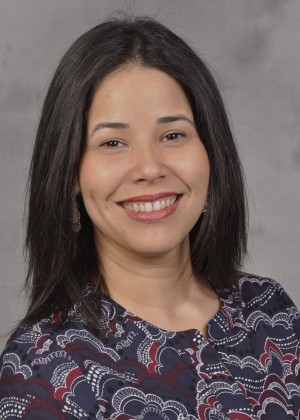Upstate researcher awarded $1.6 million grant to unlock the secrets of the optic chiasm: advancing understanding of the extracellular matrix for vision restoration
Reyna I. Martinez-De Luna, PhD, a researcher from Upstate, has been awarded $1.6 million from the National Eye Institute (NEI) over the next four years. The funding aims to enhance the understanding of the role the extracellular matrix, the proteins surrounding cells, plays in guiding the nerve fibers of retinal ganglion cells to the appropriate side of the brain. This knowledge could help in efforts to restore vision after it’s been lost.

Reyna I. Martinez-De Luna, PhD, will use a grant from the NEI to better understand how β2 laminins control the routing of the retinal ganglion cell nerve fibers to the brain.
During the formation of the visual system the axons, or nerve fibers, exit the eye through the optic nerve and enter the brain at a point called the optic chiasm. The optic chiasm is a decision-making point for the ganglion cell nerve fibers; it is where they are routed to either the left or right side of the brain. The correct routing of axons is crucial for binocularity, the ability of our eyes to work together to create a single, cohesive 3D image.
The optic chiasm is lined by a specialized sheet-like structure of extracellular matrix called a basement membrane. The basement membrane is rich in proteins called β2 laminins, which researchers believe play a key role in guiding these axons.
“When you eliminate β2 laminins in a mouse, you get more axons that stay on the same side of the brain. That tells us they have a role in the decision that the retinal ganglion cell nerve fibers make when they enter the brain,” Martinez-De Luna says. This project is focused on understanding how β2 laminins control the routing of the retinal ganglion cell nerve fibers to the brain.
“Currently we know very little about how the β2 laminins influence the direction that the ganglion cell nerve fibers take when the visual pathway is forming. Correct routing is critical for visual information to reach the appropriate places in the brain and translate into vision as we know it.” This knowledge could help in efforts to restore vision after retinal ganglion cells are lost; either because of disease or injury.
Understanding this routing process is crucial to developing strategies to guide new nerve fibers to the correct side of the adult brain. The traffic signals that direct these nerve fibers disappear after early development, and bringing these signals back is key to rejuvenating the optic chiasm in adults with vision loss.
As researchers work to regenerate ganglion cells, either by activating the person’s own cells to produce new retinal ganglion cells or by transplanting new retinal ganglion cells derived from stem cells, Martinez-De Luna recognizes that a better understanding of the functions of the extracellular matrix will be crucial. “Even though we know the traffic signals produced by the cells of the optic chiasm guide the nerve fibers to the brain, my work says that we don't know everything about what controls those signals.”
The results of this study could provide valuable insights into how we can manipulate the environment in the adult optic chiasm to make it receptive to the growth of new axons and achieve the goal of restoring vision.
Martinez-De Luna is a Research Instructor of Ophthalmology and Visual Sciences, whose lab in the Center for Vision Research studies the genetic and environmental factors that regulate the development and connectivity of retinal ganglion cells (RGCs). You can read more about Martinez-De Luna’s lab work here:
https://www.upstate.edu/cvr/investigators/reyna-martinez-de-luna-phd/index.php
You can also learn more about the Center for Vision Research’s cutting-edge research here: